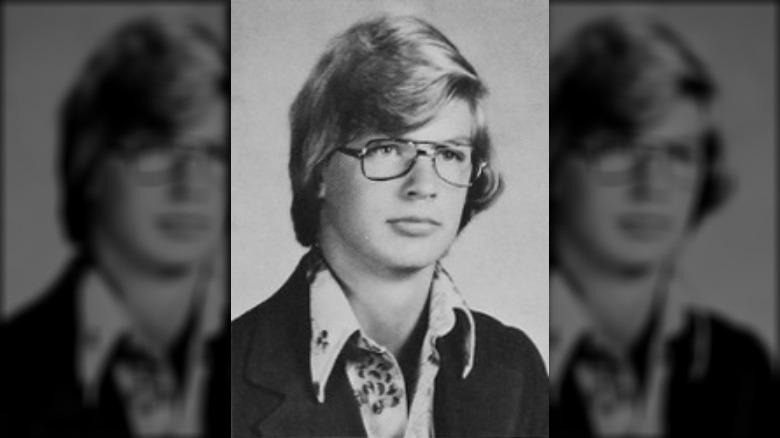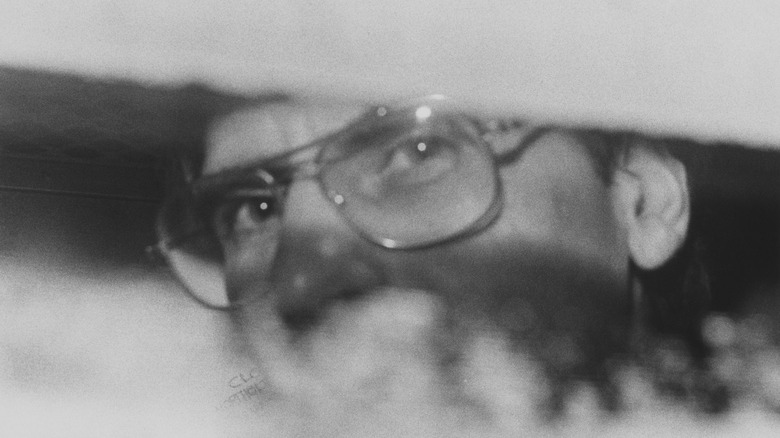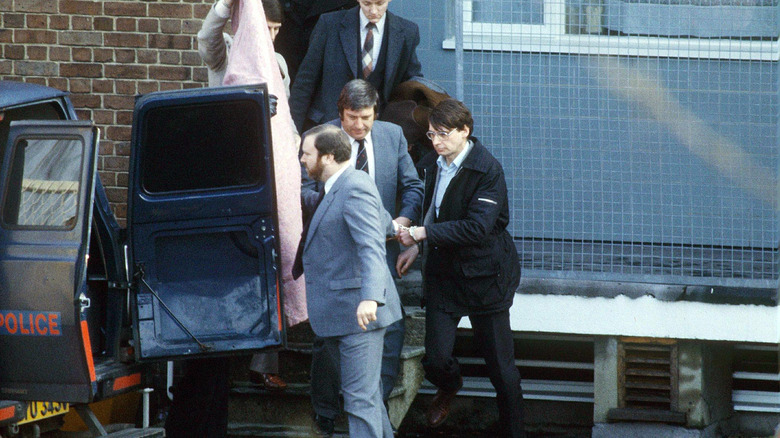The Uncanny Similarities Between Jeffrey Dahmer And Dennis Nilsen
In his bestselling 2011 book "The Psychopath Test," British journalist and broadcaster Jon Ronson explores the phenomenon of psychopathy through a controversial idea: that a checklist of traits (known as a PCL-R test) alone can be used to work out whether anybody is a psychopath. The hypothesis is highly seductive; the idea that psychopaths live among us — and potentially account for 1% of the population, according to Ronson's research — is terrifying. Equally so is the idea that we, the reader, may coldly lack some key empathetic qualities ourselves (though as a review in the Los Angeles Times points out, such anxiety over our own potential psychology is more likely a good indicator that we are harmlessly sane). Why wouldn't we want to be able to reduce the diagnosis of psychopathy as a label to a reliable yes-or-no checklist?
But most disturbing of all when it comes to psychopaths is that whether it is possible to diagnose them as cleanly as supporters of the PCL-R would have us believe, research suggests that people aren't just born with the mental disorder. While there is evidence that there may exist a genetic disposition to psychopathic behavior (per Business Insider), psychopaths are more than likely made. This dynamic is evidenced by the uncannily similar backgrounds — and crimes — of two of the world's most terrifying serial killers: Jeffrey Dahmer and Dennis Nilsen.
The killers shared similar childhoods
Despite being born and raised on two different continents, serial killers Jeffrey Dahmer (pictured above) and Dennis Nilsen have a lot in common, which becomes especially disturbing in light of their horrendous crimes.
After their arrests, the two killers would reveal the childhood and adolescent traumas that became catalysts for their later psychopathy. According to Biography, the Wisconsin-born Dahmer is believed to have been a good-natured and happy child until the age of four, when, after developing a double hernia, he was subjected to invasive surgery to correct the problem. Per Science Direct, Dahmer likely began to eschew social interaction after this trauma.
Nilsen, from Scotland, suffered his own trauma at the age of six, when his grandfather, to whom he was particularly close, died unexpectedly. At the funeral, the boy was invited to look upon the body at rest — an experience that deeply affected him (via Biography).
Both Dahmer and Nilsen were raised in unhappy households
In the debate over what exactly makes people exhibit psychopathic tendencies, the childhood experiences of serial killers — such as Jeffrey Dahmer and Dennis Nilsen — are pored over for traumatic experiences and dysfunctional family dynamics that might explain their later crimes. And somewhat strangely, in the case of the two men in question, there is considerable overlap, with both having difficult and distant relationships with their parents, jealousy in relation to their siblings, and living through difficult divorces.
The young Dahmer's childhood was a difficult one, according to "The Shrine of Jeffrey Dahmer." His father, a chemist, was often overloaded with work or away from home, while his mother, who Dahmer's father physically abused in the boy's presence, suffered from severe depression: relying on medication that kept her in a sedative state for much of Dahmer's youth. In this milieu, Dahmer began to collect and experiment with the bones and other remains of dead animals, employing bleaching techniques taught to him by his father.
According to "Killing for Company: The Case of Dennis Nilsen," Nilsen, who would become known as The Muswell Hill Murderer after the crimes he committed in the London area, had a similarly difficult childhood in his native Scotland. His father, Olav, was absent throughout his infancy, and the future serial killer had an unfriendly rivalry with his brother, Olav Jr. Nilsen's parents later divorced, and when his grandfather, to whom he was closest, died, Nilsen, who characterized himself as a naturally unhappy child, found himself adrift.
If you or someone you know is dealing with domestic abuse, you can call the National Domestic Violence Hotline at 1−800−799−7233. You can also find more information, resources, and support at their website.
They both spent time in the military
Another common thread in the early lives of both Jeffrey Dahmer and Dennis Nilsen was their time in the military, which occurred when both were still young men fresh out of school and looking for direction in the world.
Both were stationed in West Germany, though Nilsen's service began in 1964 (per "Killing for Company: The Case of Dennis Nilsen") and Dahmer's in 1979 — a year after the latter had committed his first murder, according to Brian Masters' "The Shrine of Jeffrey Dahmer." Yet another commonality between the two killers was that they took non-combat roles within the military; Dahmer was trained and deployed as a medic, while Nilsen was an army chef.
For both men, the military was also a background in which their closet homosexuality came to the fore. Per Masters, Dahmer found in the sex shops of Frankfurt a place to supply himself with a steady stream of pornography. This was an outlet for his sexual urges that he was unable to indulge with his fellow soldiers, who were used to enjoying liaisons with local women. Nilsen also strove to keep his homosexuality a secret from those around him, avoiding nudity in front of the other recruits and joining in with homophobic jibes when the occasion called for it. As Nilsen told Masters: "I never took a shower, always a bath. I was afraid that I must somehow look different and that my innermost thoughts would be exposed by my nakedness."
Dahmer and Nilsen both misused alcohol
Both Jeffrey Dahmer and Dennis Nilsen regularly drank alcohol to excess, a habit that formed early in their lives.
Dahmer began drinking heavily from the age of 14, taking hard liquor, which he described as "medicine," to school. He would later stage pranks for money so he could buy alcohol. As Brian Masters describes in "The Shrine of Jeffrey Dahmer," Dahmer's drinking became more frequent during his army days, when he and other soldiers enjoyed the benefit of half-priced booze — Dahmer and the other recruits would get drunk together most nights. Dahmer would occasionally be moved to drunken tears by the memory of his first killing, though Masters is adamant that Dahmer was more likely feeling the effects of "self-pity" for the situation he had gotten himself into, rather than regret or pity for his victim.
Nilsen was also a heavy drinker throughout his life, especially during his time in the army, when his stupors involving other young men became charged with sexual fantasies, according to "Dennis Nilsen – Conversations with Britain's Most Evil Serial Killer." Nilsen's experiences around other drunken men who were in the habit of drinking themselves into a stupor would later fuel his urges toward targeting passive victims. Both killers would later use alcohol to sedate their victims, while bars would give them each the opportunity to meet vulnerable men to prey upon.
If you or anyone you know is struggling with addiction issues, help is available. Visit the Substance Abuse and Mental Health Services Administration website or contact SAMHSA's National Helpline at 1-800-662-HELP (4357).
They started killing the same year
Though Dennis Nilsen and Jeffrey Dahmer were born many years apart — in 1945 and 1960, respectively — the periods in which they committed their crimes overlapped to an uncanny degree, with both men claiming their first victims in the same year: 1978.
According to Brian Masters' "The Shrine of Jeffrey Dahmer," Dahmer's first victim was a man named Steven Hicks, a hitchhiking teenager from Illinois who got into Dahmer's car and went with him back to his home, to talk and drink alcohol — a trap that Dahmer would lay for many of his victims in the years that followed. When Hicks announced that it was time for him to leave, Dahmer struck him with a barbell that he had retrieved from the cellar. Hicks fought back, but fell unconscious after another blow with the bar: Dahmer then choked him to death with the same object.
The story of Nilsen's first murder shares many similarities with that of Dahmer. As described in "Dennis Nilsen – Conversations with Britain's Most Evil Serial Killer," his victim, Stephen Holmes, had returned to Nilsen's home to drink alcohol. When Nilsen feared that Holmes might leave, he attacked and killed him. Like Dahmer, Nilsen then abused his victim's dead body. Nilsen's first victim was not identified for many years. Per Wales Online, it was only after Nilsen himself had confessed to the murder in a letter to a British newspaper in 2006, did the killing come to light.
The parallel crimes of Dahmer and Nilsen
When Jeffrey Dahmer and Dennis Nilsen (pictured above) began killing in 1978, they each targeted vulnerable young men — lone travelers, homeless men, or drinkers — and lured them to their homes, where they brutally murdered them. Dahmer's first victim was a hitchhiker named Steven Hicks, whom he murdered at his parent's house. Afterward, he buried the body before exhuming it and pulverizing the bones (via Biography). Nilsen's first victim was a man he had met in a London pub before strangling him at his home the next morning (via Biography).
In both cases, the violence occurred after the victim had expressed their intention to leave. It is believed that both killers' psychopathy was related to extreme feelings of abandonment that first developed in their adolescence and subsequently manifested in a perverse sexual attraction to passive bodies — both unconscious and dead. Both killers would go on to murder many more young men for their sexual pleasure — Dahmer killed a total of 17, while Nilsen is believed to have killed between 12 and 15. In addition, both murderers retained the bodies of their victims for long periods before dismembering and disposing of them.
However, the two serial killers differed greatly in their ultimate fates: while Nilsen died in hospital of a pulmonary embolism on May 12, 2018, at the age of 72 (via BBC), Dahmer was beaten to death behind bars by a fellow inmate Christopher Scarver in 1994, aged 34.
Like many serial killers, both kept trophies of their victims
Jeffrey Dahmer and Dennis Nilsen both shared an attraction to the remains of their victims. Indeed, possessing the dead bodies of those they killed appears to have been the desire that drove their heinous actions, rather than the moment of murder itself.
As Brian Masters describes in "The Shrine of Jeffrey Dahmer," Dahmer had a habit of making trophies of the body parts of the men he killed, in the same way that he retained the remains of the dead animals he encountered during his youth. Typically, Dahmer would bleach and then paint the skulls of his victims and display them on his mantel, though he would also keep other body parts — such as bicep muscles — that he found particularly attractive.
Nilsen would live with the bodies of those he killed for months on end. Per "Killing for Company: The Case of Dennis Nilsen," Nilsen would hide bodies under his floorboards and exhume them occasionally to bathe and interact with them. He would later say that in his victims, he had discovered a "new kind of flatmate."
Dahmer and Nilsen were both nearly caught after a victim escaped
Jeffrey Dahmer and Dennis Nilsen succeeded in murdering scores of young men during the years they were active as serial killers. However, both men came very close to having their appalling actions discovered by police, well before they were finally caught and brought to justice.
In Dahmer's case, the escapee was a 14-year-old boy named Konerak Sinthasomphone, as described in "The Shrine of Jeffrey Dahmer," whom Dahmer had lured to his apartment to pose for photographs and then, while drunk, had injected his brain with muriatic acid. While in a stupor, the teenager had, in Dahmer's absence, left the building covered in blood, where he met some locals and was encountered by the police. However, when Dahmer arrived, he was able to convince the police that he was Sinthasomphone's boyfriend, and the officers returned the victim to the killer's care. The police even came to Dahmer's home — where a body lay hidden in a bedroom — but found nothing unusual. Sinthasomphone was murdered days later.
Nilsen's close encounter with the law occurred after he took home a student named Andrew Ho, whom he had met in a bar and lured home after discussing bondage. According to "Killing for Company: The Case of Dennis Nilsen," after Nilsen took Ho home and choked him with a necktie around his neck, Ho managed to escape the killer and contact the police. However, he decided not to have Nilsen arrested after the incident. Tragically, both Dahmer and Nilsen went on to kill again before they were ultimately captured.








